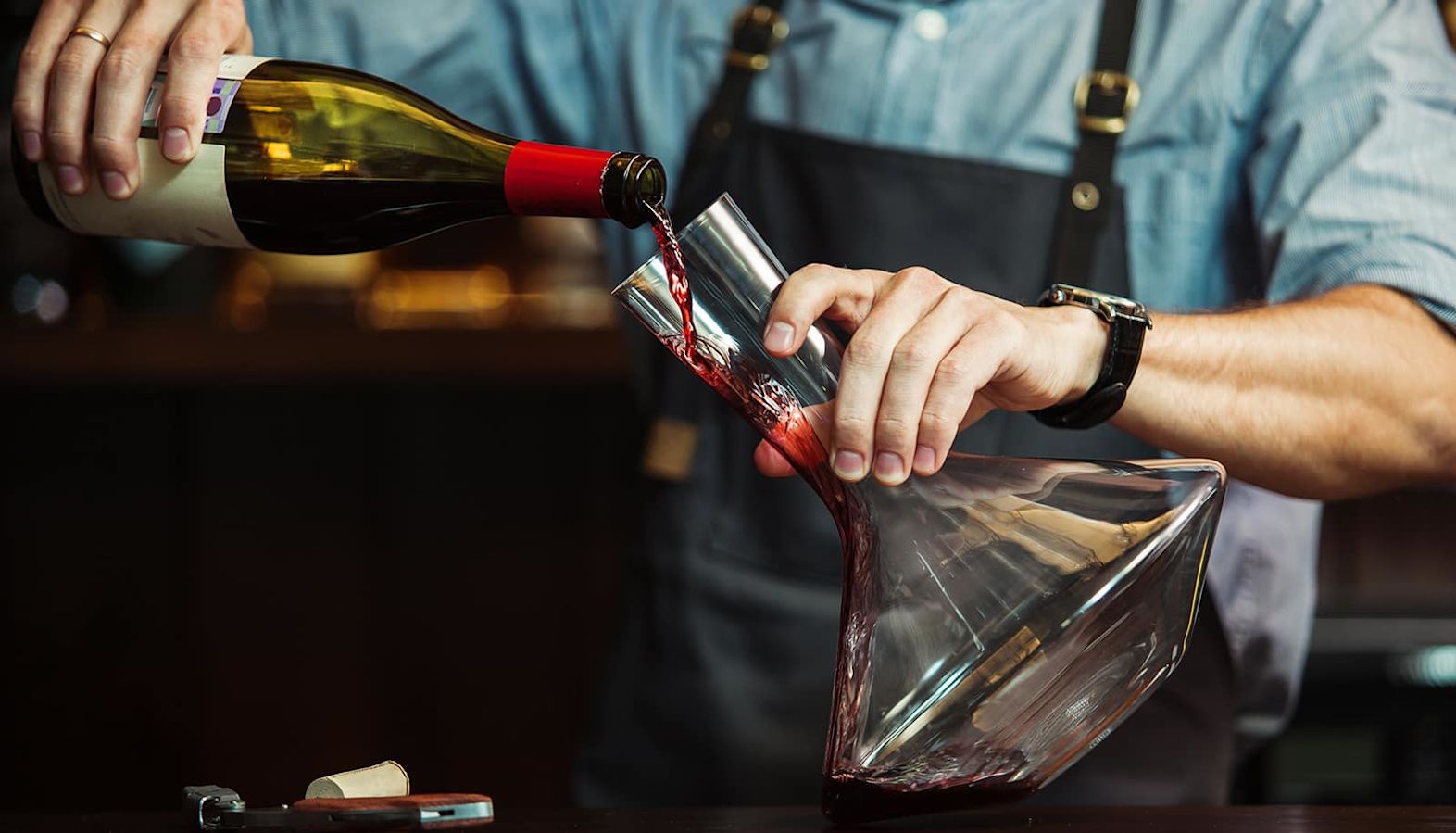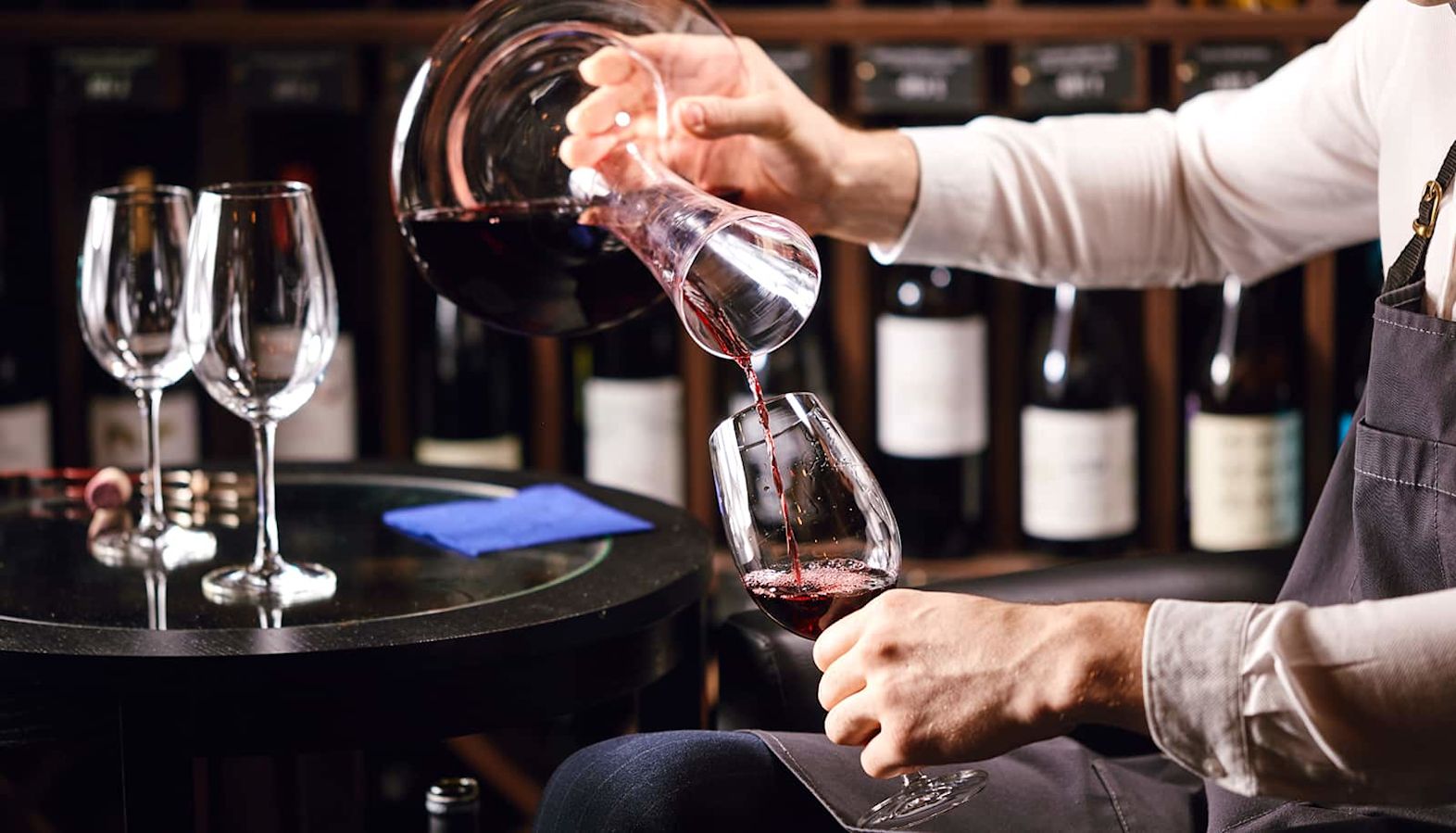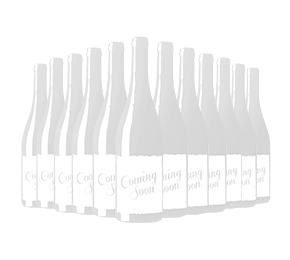Chat with Vinny
To decant or not to decant? That is the question when it comes to opening a new bottle of wine. While there are no hard and fast rules when it comes to decanting a wine, there are a few tips and tricks that will improve your drinking experience no end. Read on to find out more.
You can spend an absolute fortune on a decanter.
Take the silver-mounted, cut-glass wine decanter sold by Christie’s in 2008.
OK, it was by Fabergé. It did bear the Imperial warrant, Moscow, circa 1890. And, yes, it had all sorts of fancy of chevrons and flutes around the neck and stylized leaves at the base. But £22,500? Even if you don’t go for an antique decanter, top glassware manufacturers like Riedel charge anything from £35 up to £1,750. Which begs the question: are they worth it? Seems like a lot of money to simply pour your wine from one glass container (its bottle) into another.
Is decanting wine simply old-fashioned and unnecessary? Something slightly pretentious and intimidating. After all, an entire culture of equipment, techniques and tricks has grown up around the spectacle of decanting. Flickering candles, fine muslin cloth, hushed silences! Or is it a totally practical and justifiable part of wine’s pomp and circumstance?
Certainly decanting wine “adds drama to the simplest of dinners”. That’s according to Christie's wine specialist, Charles Foley – and who would disagree. But does decanting do more than add a little showmanship to your dinner party?

What history has to say about decanting wine
The decanter's history dates back more than 2,000 years.
So, surely its purpose must be more than just decorative?
Let’s take a look at when it started. In ancient Rome, wine was transported around the empire in large clay jars known as pithoi. They then decanted it into smaller, more decorative containers to serve at table.
During the Renaissance, the Venetians pioneered glass decanters. These were designed to increase the surface area of wine so it could react with air. And then in the 1730s, British glassmakers invented the stopper to limit exposure to air and allow wine to be stored for longer.
‘Claret jugs’ began to appear from around 1800. With a handle and pouring lip, they were used often used for serving port and sherry as well as red wine. By the middle of the 19th century, the decanter was at the height of its popularity.
So why do you need to decant your wine?
There are two reasons: sediment and aeration.
First: as the Romans discovered, as wine matured it left a sediment. This didn’t pose any sort of health risk, it just didn’t taste good. And when they decanted the wine from the larger amphorae to serve at table, they found they could remove the sediment too.
Second: the Venetians found that increasing the surface area of their glass decanters meant the wine reacted with the air. This helped improve the aromas and flavours.
“Aerating the wine,” says Christie’s expert Charles Foley, “is similar to shaking a crumpled blanket or a throw on a bed. The air smooths the creases and crinkles so that the tannin appears plump and rounded.” Switch the metaphor to fluffing up a duvet, and it works even better.
You see, wines spend quite a while inside the bottle with no oxygen exposure. Letting the wine ‘breathe’ helps expands all the dormant aromas and flavours. Aeration releases the accumulated gases and softens the tannins.
Which red wines benefit from being decanted?
One thing is clear: decanting isn’t just for mature reds with sediment.
Young, heavier reds with vibrant fruit and fine-grained tannins will definitely benefit from a period of aeration. As will lighter styles. Both styles will open up and show at their very best with some carefully timed decanting.
Light bodied reds – 20 to 30 minutes
Beaujolais (made from the Gamay grape)
Medium bodied reds – 30 to 60 minutes
Full bodied reds – 60 to 120 minutes
PLEASE NOTE: Take care when it comes to decanting older wines.
How to decant a wine with sediment
Set the bottle upright for 24 hours or more before drinking, so the sediment can slide to the bottom of the bottle, making it easier to separate.
Locate a decanter or other clean, clear vessel from which the wine can easily be poured into glasses.
Remove the capsule and cork; wipe the bottle neck clean.
Hold a light under the neck of the bottle; a candle or flashlight will work well.
Pour the wine into the decanter slowly and steadily, without stopping; when you get to the bottom half of the bottle, pour even more slowly.
Stop as soon as you see the sediment reach the neck of the bottle. Sediment isn’t always chunky and obvious; stop if the wine’s color becomes cloudy or if you see what looks like specks of dust in the neck.
The wine is now ready to serve. Discard the remaining ounce or two of sediment-filled liquid in the bottle. (You can always add this to the gravy if you’re having a roast – but remember to sieve it!)
Older red wines do not need long periods of aeration. In fact, it could make the flavours fade.

White wines can be worth decanting too!
White wines may be less frequently decanted. But that doesn’t mean they shouldn’t be. After all, they can be just as aromatic, full-bodied and complex as red wines. So, do them a favour and give them an equal chance to blossom in your glass. You’ll be in good company.
The British wine critic (and President of The Sunday Times Wine Club) Hugh Johnson, famously decants old Riesling. His fellow wine writer and old Rugbeian, the late Steven Spurrier, liked to decant white Rhône. While in Bordeaux, white wines are often decanted before they are served.
Decanting will also help an over-chilled white wine gently increase in temperature. If Chardonnay is served too cold, it will seem more acidic. Room-temperature Chardonnay will show its full breadth of aromas and flavours.
So what about sparkling and rosé wine?
Very rarely needed!
Grower Champagne is sparkling wine made by the same estate that owns the vineyards where the grapes are grown. Both it, and some rosé wines, can have reduction.
You can tell if your wine is reduced if it lacks aromas or smells like:
Rotten eggs
Burnt rubber
Garlic
That burnt match smell
That is the burnt match smell you sometimes catch on opening. This will fade away with decanting. Reduced white wines and rosés need to decant for up to 30 minutes, although 15 minutes should be more than enough. If you wait the right amount of time, the fruity scents will return.

How to choose your decanter
You will have your own preferences, as regards looks.
But remember, you need a wide bowl to be able to swirl the wine. And a narrow neck to funnel the liquid into the glass and avoid spraying a tablecloth. Here’s a quick rundown of the sort of decanters on the market today:
Standard Decanters
These are the classic models. Typically, they have a wide, flat bottom and a narrow neck, resembling a vase. The wide bottom increases the surface area of the wine exposed to air, enhancing aeration.
Swan/Duck Decanters
So named for their long, curved necks and graceful shapes that resemble swans or ducks. They often have a handle and a wide spout for easy pouring. The unique design maximises aeration and makes a great impression on the table!
Bell/Shaped Decanters
Shaped like a bell, these decanters have a wide base that narrows sharply towards the neck. This design allows for excellent aeration and is particularly effective for young, robust wines that need more air to open up.
Cornetto Decanters
These resemble a horn or cornet. They have a narrow base and a long, curved neck. Often used for older wines as the narrow base minimises air exposure, allowing for more controlled aeration.
Wine Breathers
Wine breathers are designed to aerate wine quickly. Some models double as serving vessels, with a mechanism that allows the wine to be poured back into the original bottle after aeration. They are ideal for those short on time but still wanting to enhance their wine's flavours.
How to decant a vintage port:
It’s a classic image.
Port in a fine decanter, being passed to the left. But not all port needs to be decanted. Tawny Port for example, is aged in oak vats or casks and filtered before bottling, so there's little to no sediment. However, you might just like the showmanship.
Vintage Port, on the other hand, does need to be decanted. It's bottled unfiltered and matures in the bottle, so sediment builds up over time. Decanting removes the sediment and lets the wine's aromas develop.
Allow the bottle to stand upright for 10-15 minutes if it’s less than 40 years old, and up to 30 minutes if older.
Pour the wine slowly and steadily into your decanter, only stopping when you see sediment in the bottle neck.
For vintages up to 40 years old, decant two to three hours before serving. For older vintages – 30 minutes to an hour.
Finally, how do you clean a decanter?
Over time, decanters can get stained.
So, it’s recommended to clean your decanter as soon as you can after using. This will make removing stubborn sediment stains that much easier.
However, it’s best to avoid using a dishwasher. Detergents leave a residue and some decanters are too fragile for repeated hot machine washes.
Here are some tips:
Use a long-handled, flexible brush to gently scrub the decanter, reaching all corners.
Pour hot water and vinegar into the decanter and let it sit for 10 minutes.
Use denture tablets: drop one tablet into the decanter filled with warm water and let it fizz.
Crushed ice can also be effective for scrubbing away stains.
Use wine decanter beads: these reach areas you can’t get to with a with a brush or cloth.
Add coarse salt and lemon juice to the decanter to dislodge residue.
White rice can act as an abrasive to clean where you cannot.
Turn it upside down to dry. And start planning its next outing!

About the author
Richard Bull
Although good at running up hills, Richard failed to make the military cuvée and turned instead to the drinks trade. After stints at Hennessy, Oddbins and Grants of St James, he arrived at Laithwaites. Here, he spent 15 years writing about real wine and the people who make it. As he wrote from the desk to your door, he was lucky enough to visit vineyards in France, Italy, Spain and Kent - as well as being flown over South Africa's Breede River by a winemaking army veteran who'd just had a heart attack. Qualified to WSET Level 3, he loves the off-the-beaten track reds of the Languedoc, but is currently obsessed with all drops Greek - particularly their super crisp whites.

